Exercise - Set up your Azure DevOps environment
In this unit, you'll make sure that your Azure DevOps organization is set up to complete the rest of this module. You'll also create the Azure App Service environments that you'll deploy to.
To accomplish these goals, you'll:
- Add a user to ensure Azure DevOps can connect to your Azure subscription.
- Set up an Azure DevOps project for this module.
- On Azure Boards, move the work item for this module to the Doing column.
- Make sure your project is set up locally so that you can push changes to the pipeline.
- Create the Azure App Service and Azure Functions app using the Azure CLI in Azure Cloud Shell.
- Create pipeline variables that define the names of your App Service and Azure Functions instance.
- Create a service connection that enables Azure Pipelines to securely access your Azure subscription.
Add a user to Azure DevOps
To complete this module, you need your own Azure subscription. You can get started with Azure for free.
Although you don't need an Azure subscription to work with Azure DevOps, this exercise is using Azure DevOps to deploy to Azure resources in your Azure subscription. To simplify the process, use the same Microsoft account to sign in to both your Azure subscription and your Azure DevOps organization.
Important
If you sign in with different accounts, then you should add a user to your DevOps organization under the Microsoft account that you use to sign in to Azure. For more information, see Add users to your organization or project. When you add the user, choose the Basic access level.
Then, sign out of Azure DevOps and sign in with the new user account. Use the Microsoft account that you use to sign in to your Azure subscription.
Get the Azure DevOps project
Make sure that your Azure DevOps organization is set up to complete the rest of this module. To do so, you'll run a template that creates a project in Azure DevOps.
The modules in this learning path form a progression as you follow the Tailspin web team through their DevOps journey. For learning purposes, each module has its own Azure DevOps project.
Run the template
Run a template that sets up your Azure DevOps organization:
From the Azure DevOps Demo Generator site, select Sign In. If prompted, accept the usage terms. The Create New Project page appears.
On the Create New Project page, enter a project name, such as Space Game - web - Azure Functions, and then for Select Organization, select the organization that you use for your Azure subscription.
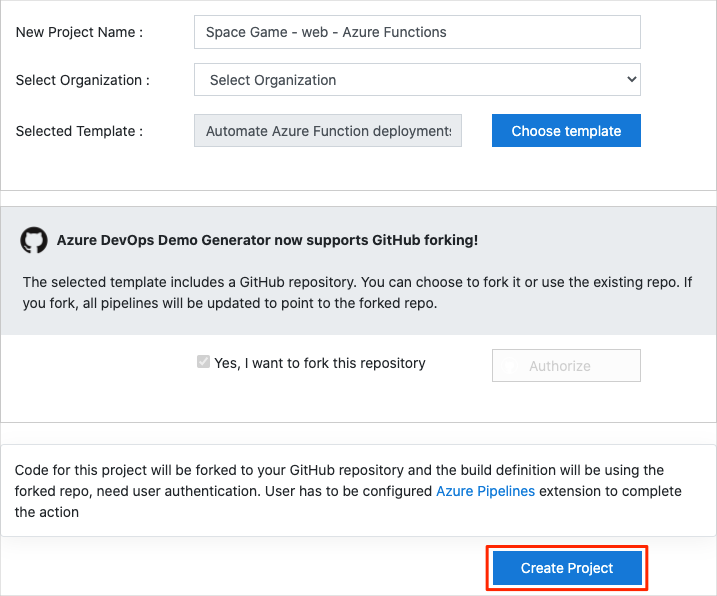
In the next section, select Yes, I want to fork this repository, and then select Authorize.
If a window appears, authorize access to your GitHub account.
Important
The enabling this fork option is necessary for the template to connect to your GitHub repository. Select it even if you've already forked the Space Game website project. The template uses your existing fork.
Select Create Project.
The template takes a few moments to run.
When the project is successfully provisioned, select Navigate to project to go to your project in Azure DevOps.
Important
The Clean up your Azure DevOps environment page in this module contains important steps that you must complete, even if you don't complete this module. Cleaning up helps ensure that you don't run out of free build minutes.
Set your project's visibility
Initially, your fork of the Space Game repository on GitHub is set to public while the project created by the Azure DevOps template is set to private. A public repository on GitHub can be accessed by anyone, while a private repository is only accessible to you and the people you choose to share it with. Similarly, on Azure DevOps, public projects provide read-only access to non-authenticated users, while private projects require users to be granted access and authenticated to access the services.
At the moment, it is not necessary to modify any of these settings for the purposes of this module. However, for your personal projects, you must determine the visibility and access you wish to grant to others. For instance, if your project is open source, you may choose to make both your GitHub repository and your Azure DevOps project public. If your project is proprietary, you would typically make both your GitHub repository and your Azure DevOps project private.
Later on, you may find the following resources helpful in determining which option is best for your project:
- Use private and public projects
- Quickstart: Make your private project public
- Setting repository visibility
Assign a work item and move it to the Doing state
Here, you'll assign a work item to yourself on Azure Boards and set the work item state to Doing. In practice, you and your team would create work items at the start of each sprint, or work iteration.
This exercise creates a checklist from which to work. It gives other team members visibility into what you're working on and how much work is left. The work item also helps enforce work-in-progress (WIP) limits so that the team doesn't take on too much work at one time.
From Azure DevOps, navigate to Boards category, and then select Boards from the menu.
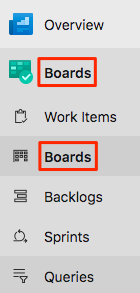
Open the Refactor leaderboard API as an Azure Function work item by selecting the title. Assign this work item to yourself, and then select Save & Close.
Select the down arrow at the bottom of the card and select Doing or select the card and drag it to the Doing column.

The work item is moved from the To Do column to the Doing column.
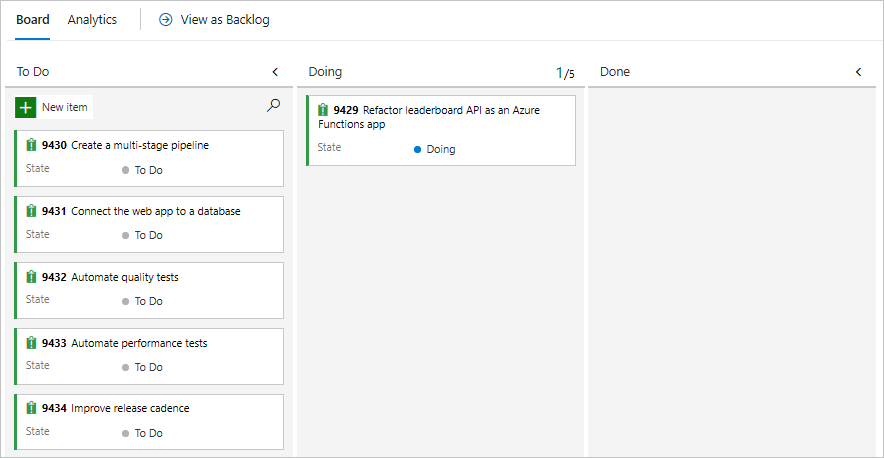
At the end of this module, you'll move the card to the Done column after you complete the task.
Create the Azure App Service and Azure Functions environments
Here, you'll create the App Service and Azure Functions app required to deploy the new version of the site and API.
In the Create a release pipeline with Azure Pipelines Learn module, you brought up App Service through the Azure portal. Although the portal is a great way to explore what's available on Azure or to do basic tasks, bringing up components such as App Service can be tedious.
In this module, you use the Azure CLI to bring up an App Service instance. You can access the Azure CLI from a terminal or through Visual Studio Code. Here, we'll access the Azure CLI from Azure Cloud Shell. This browser-based shell experience is hosted in the cloud. In Cloud Shell, the Azure CLI is configured for use with your Azure subscription.
Important
You need your own Azure subscription to complete the exercises in this module.
Bring up Cloud Shell through the Azure portal
Sign in to the Azure portal.
From the global controls in the page header, select Cloud Shell.

A terminal opens and connects to the Azure Cloud Shell.
If necessary, select Bash from the terminal menu.
Note
Cloud Shell requires an Azure storage resource to persist any files that you create in Cloud Shell. When you first open Cloud Shell, you're prompted to create a resource group, storage account, and Azure Files share. This setup is automatically used for all future Cloud Shell sessions.
Select an Azure region
A region is one or more Azure datacenters within a geographic location. East US, West US, and North Europe are examples of regions. Every Azure resource, including an App Service instance, is assigned a region.
To make commands easier to run, let's start by setting a default region. After you specify the default region, commands you enter use that region until you specify a different region.
From Cloud Shell, run the following
az account list-locationscommand to list the regions that are available from your Azure subscription:az account list-locations \ --query "[].{Name: name, DisplayName: displayName}" \ --output tableFrom the
Namecolumn in the output, choose a region that's close to you. For example, chooseeastasiaorwestus2.Run
az configureto set your default region. Replace<REGION>with the name of the region you chose.az configure --defaults location=<REGION>This example sets
westus2as the default region:az configure --defaults location=westus2
Create Bash variables
Here, you'll create Bash variables to make the setup process more convenient and less error-prone. Using variables for shared text strings helps avoid accidental typos.
From Cloud Shell, generate a random number, which we will use to create globally unique names for certain services in the next step.
resourceSuffix=$RANDOMCreate three globally unique names for your App Service, Azure Function, and storage accounts. These commands use double quotes, which instruct Bash to resolve the variables using inline syntax.
webName="tailspin-space-game-web-${resourceSuffix}" leaderboardName="tailspin-space-game-leaderboard-${resourceSuffix}" storageName="tailspinspacegame${resourceSuffix}"Create two more Bash variables to store the names of your resource group and service plan.
rgName='tailspin-space-game-rg' planName='tailspin-space-game-asp'
Create the Azure resources required
Our solution requires several Azure resources for deployment, which we'll create now.
Note
This exercise uses the default network settings, so that your site is accessible from the internet. In practice, you could configure an Azure virtual network to put your website in a network that only you and your team can access. Later, you could reconfigure your virtual network to make the website available to your users.
Run the following
az group createcommand to create a resource group using the name defined earlier:az group create --name $rgNameRun the following
az appservice plan createcommand to create an App Service plan using the name defined in the previous task:az appservice plan create \ --name $planName \ --resource-group $rgName \ --sku B1 \ --is-linuxThe
--skuparameter specifies the B1 plan. This plan runs on the Basic tier. The--is-linuxparameter specifies Linux workers (threads used in events and task scheduling).Important
If the B1 SKU isn't available in your Azure subscription, choose a different plan, such as S1 (Standard).
Run the following
az webapp createcommand to create the App Service instance:az webapp create \ --name $webName \ --resource-group $rgName \ --plan $planName \ --runtime "DOTNETCORE|6.0"Azure Functions requires a storage account for deployment. Run the following
az storage account createcommand to create it:az storage account create \ --name $storageName \ --resource-group $rgName \ --sku Standard_LRSRun the following
az functionapp createcommand to create the Azure Functions app instance. Replace the<region>with your preferred region.az functionapp create \ --name $leaderboardName \ --resource-group $rgName \ --storage-account $storageName \ --functions-version 4 \ --consumption-plan-location <region>Run the following
az webapp listcommand to list the host name and state of the App Service instance:az webapp list \ --resource-group $rgName \ --query "[].{hostName: defaultHostName, state: state}" \ --output tableNote the host name for your running service. It should look similar to the following, but the random-number identifier will differ. You'll need the web host name later when you verify your work.
HostName State ---------------------------------------------- ------- tailspin-space-game-web-4692.azurewebsites.net RunningRun the following
az functionapp listcommand to list the host name and state of the Azure Functions instance.az functionapp list \ --resource-group $rgName \ --query "[].{hostName: defaultHostName, state: state}" \ --output tableNote the host name for your running service. It should look similar to the following, but the random number identifier will differ. You'll need the leaderboard host name later when you verify your work.
HostName State ------------------------------------------------------ ------- tailspin-space-game-leaderboard-4692.azurewebsites.net RunningCopy these two host names to a location you can easily access later.
As an optional step, open a browser and enter a host name to verify that it's running. The default home page appears.
Important
The Clean up your Azure DevOps environment page in this module contains important cleanup steps. Cleaning up helps ensure that you're not charged for Azure resources after you complete this module. Be sure to perform the cleanup steps even if you don't complete this module.
Create pipeline variables in Azure Pipelines
In the Create a release pipeline with Azure Pipelines module, you added a variable to your pipeline that stores the name of your web app in App Service. Here, you'll do the same. In addition, you'll add the name of your leaderboard app for the Azure Functions instance.
You could hard-code these names in your pipeline configuration, but if you define them as variables, your configuration will be more reusable. Plus, if the names of your instances change, you can update the variables and trigger your pipeline without modifying your configuration.
Let's add a variable group to your project.
Your Space Game - web - Azure Functions project should be open in Azure DevOps.
In the menu, select Pipelines, and then, under Pipelines select Library. The Library pane appears.
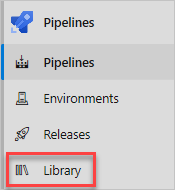
In the command bar or in the middle of the pane, select Variable group. The New variable group page appears.
For the variable group name, enter Release.
Under Variables, select Add.
For the name of your variable, enter WebAppName. For the value, enter the name of the App Service instance that was created for your web app, such as tailspin-space-game-web-4692.
Important
Set the name of the App Service instance, not its full host name. In this exercise, for example, tailspin-space-game-web-4692 is the instance part of the host name tailspin-space-game-web-4692.azurewebsites.net.
Add another variable named LeaderboardAppName with the value of your leaderboard instance, for example, tailspin-space-game-leaderboard-4692.
Add a final variable named ResourceGroupName with the value tailspin-space-game-rg.
In the command bar near the top of the page, select Save to save your Release variable group to the pipeline.
The variables in your variable group should be similar:
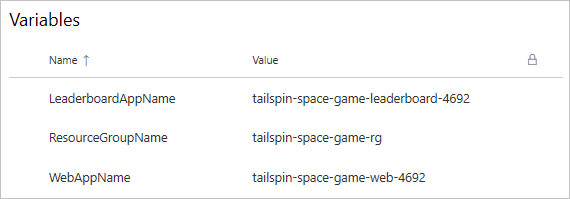
Create the spike environment
In previous modules, you created environments for dev, test, and staging environments. Here, you'll do the same. This time, you'll create an environment named spike.
From the Azure DevOps menu, under Pipelines, select Environments.
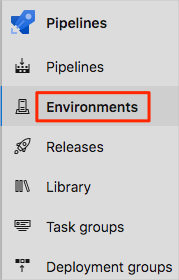
Select Create environment. The New environment pane appears.
For Name, enter spike.
Leave the remaining fields at their default values.
Select Create.
Create a service connection
Here, you'll create a service connection that enables Azure Pipelines to access your Azure subscription. Azure Pipelines uses this service connection to deploy the website to App Service. You created a similar service connection in the previous module.
Important
Make sure that you're signed in to both the Azure portal and Azure DevOps under the same Microsoft account.
In Azure DevOps, Space Game - web - Azure Functions pipeline project, below the menu, select Project settings. The Project details pane appears.
In the menu, under Pipelines, select Service connections.
On the Service connections page, select New service connection, and then in the New service connection pane, select Azure Resource Manager, and then select Next.
In the New service connection pane, select Service principal (automatic), and then select Next.
In the New Azure service connection pane, select or enter the following settings:
Field Value Scope level Subscription Subscription Select your Azure subscription Resource Group tailspin-space-game-rg Service connection name Resource Manager - Tailspin - Space Game During the process, you might be prompted to sign in to your Microsoft account.
Ensure that Grant access permission to all pipelines is selected.
Select Save.
Azure DevOps performs a test connection to verify that it can connect to your Azure subscription. If Azure DevOps can't connect, you have the chance to sign in a second time.